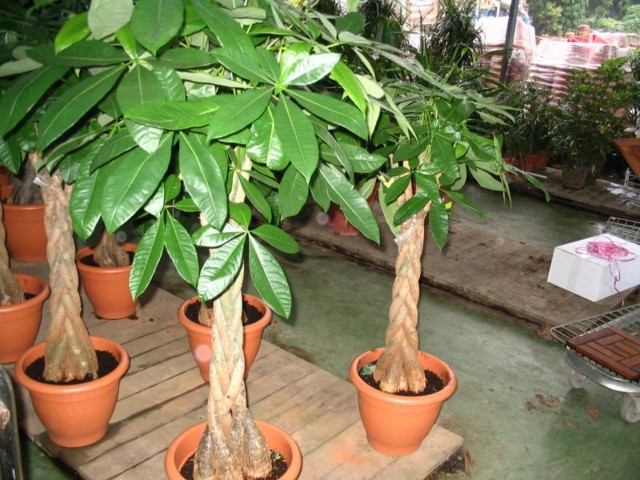
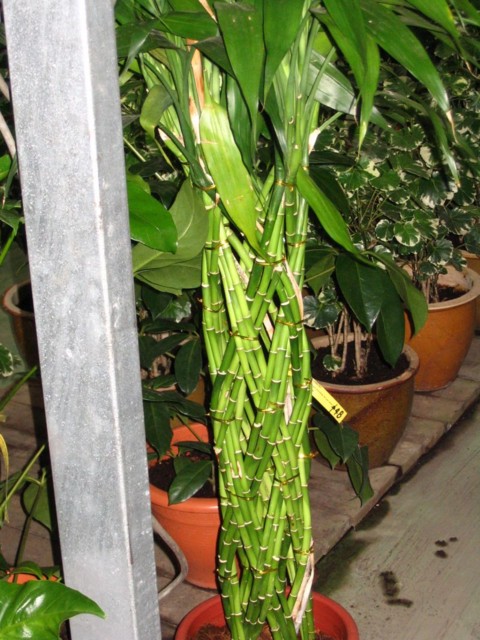
Let us review the facts: Singapore is an island. Singapore is a country. Singapore is a city.
People asked us, before we started on the trip, why we wanted to make a stop in Singapore. Isn't it pretty close to Bangkok? Can't we go from Thailand directly to Sydney? Well, it's a three hour flight and that makes the difference between a 9-hour stretch to Sydney and an 11-12 hour stretch, but that wasn't the real reason why we came there.
We came because this was our first trip east of Israel, and we thought that if we're already here, might as well see what's here. It's the flight - both in time and in money - that is the prohibitive factor in visiting the far east countries on a one-at-a-time basis, just like when we travel to the U.S. we never stay in just one state for the whole time of our journey. In fact, I wanted to add more countries in to the mix. I wanted to visit Japan as well, but this is where our time and money constraints stepped in, and I think that in retrospect that was the correct call.
With all this having been said, our final conclusion of Singapore is that it is a boring place from a tourist's perspective, and we probably won't take vacations there again.
Some things you should know before going to Singapore.
The first thing to know is that the country is right on the equator. Therefore, it has no seasons and a very tropical weather. That means very hot, constant 100% humidity and unexpected changes from bright sunshine to pouring rain. Even the locals constantly carry around with them a towel to wipe off the sweat. That's how humid it is. As for the rain, people in Singapore don't use umbrellas much. They're pretty pointless. When the rain comes in, they just duck into the nearest sheltered place and wait it out. If the rain goes on for more than an hour, they just walk in it and get wet. It's not like the rain is much wetter than the humidity and the sweat you're constantly bathed in.
We were pretty lucky with the weather. On two of the three days that we were there (the first and the last) there was no rain to speak of and we got to see many of the sights. Only on one day were we surprised by a sudden rain and developed a sudden, unexplained keenness to look at pot-plants in a nearby, rain-sheltered plant-nursery for the next hour.


Turns out even that wasn't enough. The rain continued the whole day. There were moments in which it subsided enough for us to venture into the national botanical gardens
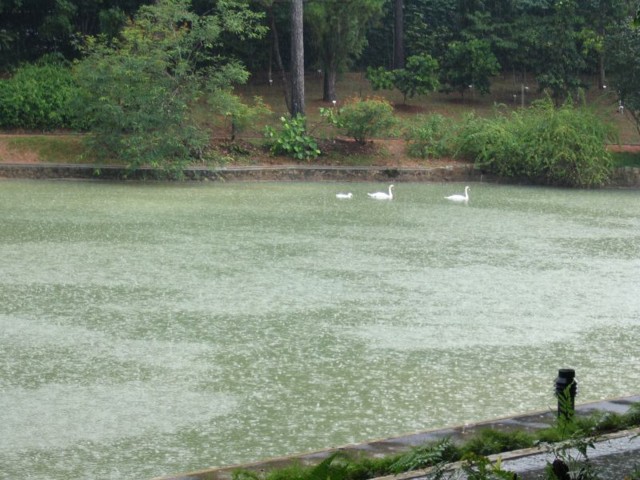

but ultimately we escaped back to the hotel. This is a very important point: when visiting Singapore, make sure your hotel is a place where you'll be comfortable spending a days-long spell of rain. Ours was.
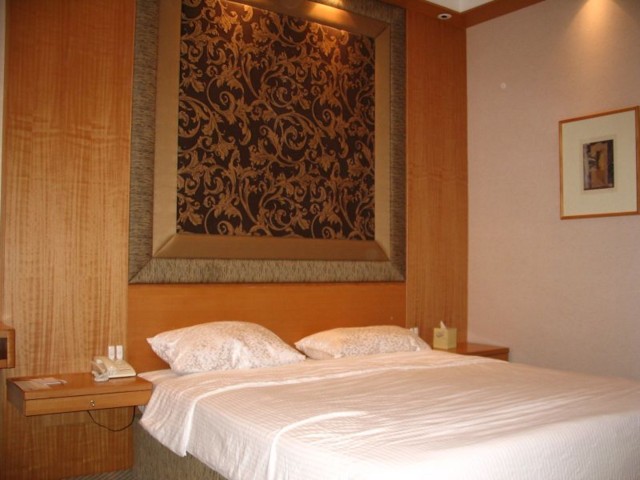

But the view from the window was nothing like what we had in Bangkok.

The other thing to know about Singapore is that if you look in a world atlas, you'll find that they speak English. This, however, is a lie on the part of the atlas. What they speak, sometimes known as "Singlish", is nothing like any English that we know. Sustaining any form of communication by use of this language is horrid. We needed to spend minutes asking people questions like "Is it right or left here in order to reach the botanical gardens?" and at the end of these conversations we usually smiled, said thank you, and walked away not one bit the wiser.
Singlish is a very similar language to what is spoken in both Hong Kong and Thailand (with tourists), though neither of these places names English as an official language. I wonder how they manage to communicate between each other, and have no choice but to conclude that they must do so in Cantonese. Orit and I have been in many places in the world, including places where we didn't speak a word in the native language, and never have we been so thwarted at our attempts to communicate as here in Singapore. Asking directions of a passerby in Italy, where all we had in common were hand-gestures, was by comparison a piece of cake.
It is good, therefore, that we managed to make our way there into one of the landmark establishments of Singapore, where they speak the universal language of tea.
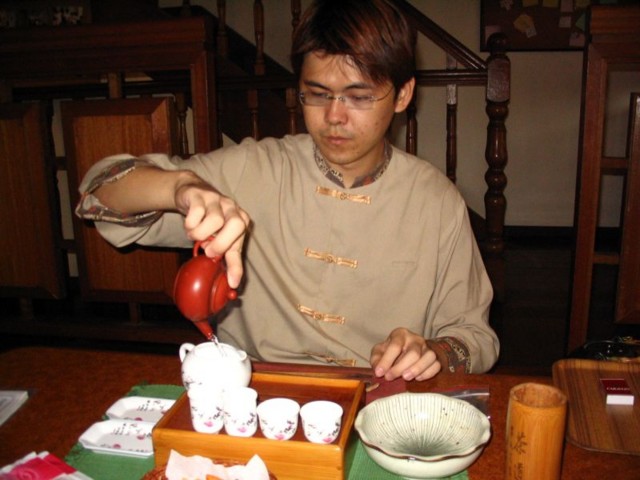

Sadly, they also speak the universal language of money, and we had to speak quite a lot of it back there.
On the way to the Tea House, we had a long walk that passed through many of Singapore's famous quarters.
We passed through "Little India", where the Chai is good but the constant smell of incense and Saffron and Cumin will kill you after a while.
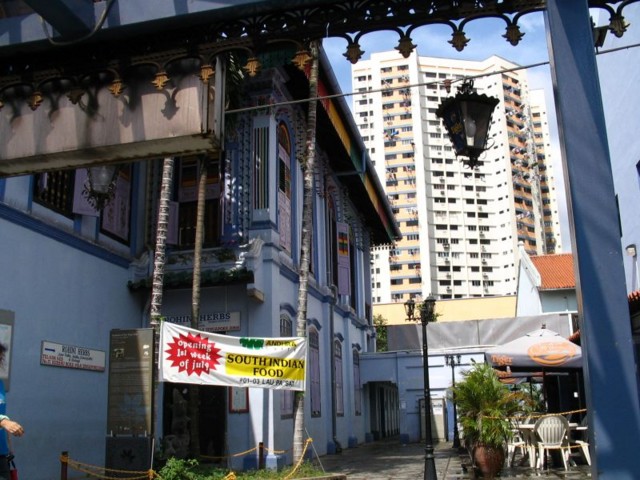
There we saw a Buddhist temple.
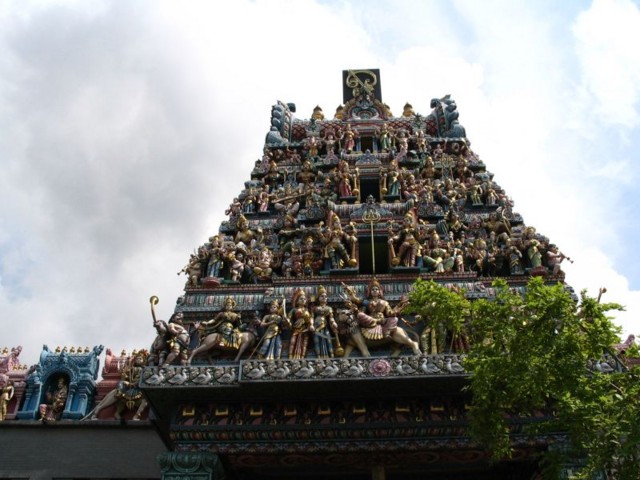
We passed through "Chinatown", where they will eat anything with anything on anything, but only when it's really raw. There we saw a Taoist temple.


Absolutely fascinating!
Three things struck me about this place. One is that they had no problem explaining there about the entire life story of the historical people who have, long after their deaths, been promoted to the stature of gods to be worshiped. The second thing that struck me is that the whole idea of worship and sacrilege is very different there than it is in cultures I am more familiar with. The gods, for example, needed to be fed. That didn't hinder people from just dumping grocery bags, often with things like UHT milk cartons, right beside the statues, where people coming to say a prayer will first see the grocery, then the statue.
The third and final thing that struck me is how so many of the symbols used here seem to appear in other cultural contexts I know, and it is unclear, at first glance, who influenced who. At the very center of the temple, for example, if you look up at the ceiling around the central supporting pillar, you can see the twelve signs of the zodiac. Well, almost. You will see eleven signs of the zodiac, and one drawing that looked to me completely out of place (maybe it was a leaf; I don't remember) replacing Virgo. Weird.
After Little India and Chinatown, we also visited Orchard Street, which is the city/country's major shop-and-restaurant area. There we ate at Black Angus. Believe me, I'll take juicy Black Angus steak over chinese boiled chicken feat any day of the week.
Only during our last day in Singapore did we find anything worthwhile to see in this country. It turns out that being right on the equator does not only mean you have tropical weather. It also means that any piece of greenery you have growing naturally around is a tropical rain forest. We decided, therefore, to venture into the small bit of forest that is right in the middle of the island. Here's what it looked like:

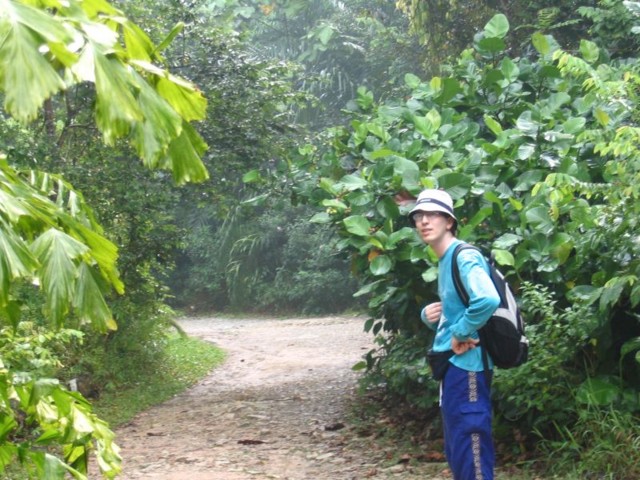
Our original plan was to go on a 2.5 km walk centering around the treetop path:
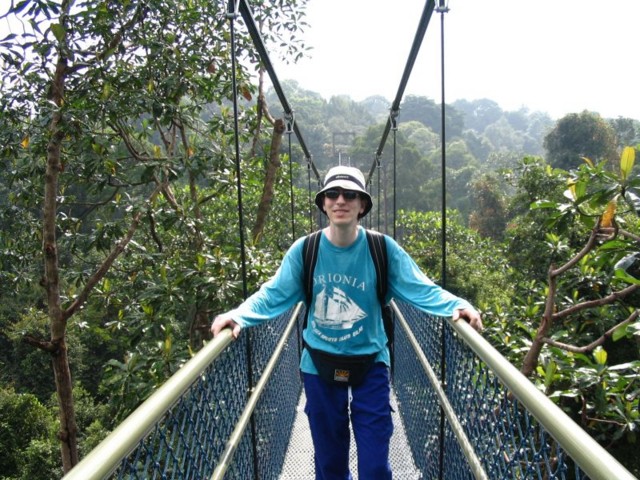

And potentially see some of the flora and fauna. This plan went wrong in almost every respect.
First, the bus driver let us out at the wrong place. We needed to cross quite a bit of the forest in order to reach the tree-top walk, making our leisurely 2.5 km walk into a strenuous 10 km walk. We couldn't afford to do it in anything less than a fast march, because we barely made it to our connecting flight that day as is. (We changed clothes at the airport bathrooms, switching between the clothes we trekked in, in the heat and humidity, and the clothes we sat in on the airplane for the following nine hours.)
Second, there wasn't that much interesting flora or fauna. Most of it was just green leaves, and, as you can see in the pictures, my glasses constantly fogged up so I could barely see anything, anyway.
Third, the "tree-top walk" turned out to be merely a bridge. It was no more than a few minutes across, and the sight from above wasn't really worth it. The 2.4 remaining kilometers of the walk were just like every other bit of forest for miles around.
We came out from the forest, panting, into the lawn of a local golf club. We asked the people nicely, and they called us a cab directly to the airport (with only one stop at our hotel, where they had our bags all ready for us to take. It took no more than a minute).
Ironically, just as we started riding in the cab, we passed through the parking lot of the golf club and right next to the entrance there were two Macaw monkeys. Turns out we didn't see any animals in the tropical rain forest because they decided to take up golf, instead. We asked the driver about that and he said (I'm translating to English): "Sure there are monkeys here in the parking lot. Here they have fruit trees."
And thus ended our short stop in Singapore, a country whose citizens call "a very fine country", due to the fact that they have a $500 fine for just about anything, including littering, chewing gum in public, and what not.
I'll let you in on a little secret: despite all this fine policy and the "let's all be clones" mentality we came across
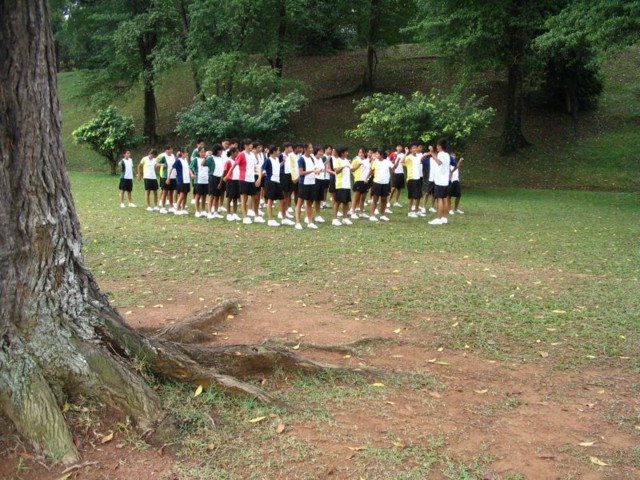
I found Singapore to be no cleaner than Tel Aviv, and the city no more pleasant.
Final verdict: I hope they're happy; I'm sure it's a wonderful country; but from the perspective of a tourist, Singapore is a complete waste of my time.
For the full range of Singapore photos (almost all courtesy of our house photographer, Orit) visit the Singapore gallery